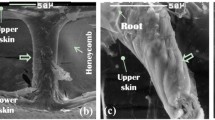Abstract
Dynastes tityus (D. tityus) is a typical beetle whose elytra are light and strong. The primary function of elytra is to protect beetle’s hindwings. In this paper, D. tityus elytra were selected as the biological prototype for the investigation to obtain bio-inspirations for the design and development of light materials with high ratio of strength to mass. Firstly, the microstructure investigation and quasi-static nanoindentation tests have been carried out on the ten samples of the selected elytra of D. tityus to reveal their mechanical properties and microstructures. Secondly, based on the findings from the microstructure investigation and nanoindentation tests, three models of bio-inspired materials have been proposed for further study to gain the deep understanding of the relationships between the special mechanical characteristics and microstructures. Then Finite Element Analysis (FEA) simulations have been performed on the three models for harvesting the bio-inspirations for the initial design of light materials. Finally, through comparative analysis of the findings from the microstructure investigation, the nanoindentation tests and the simulations, some meaningful bio-inspirations have been reaped for the future optimization of the design and development of light materials with high ratio of strength to mass.
Similar content being viewed by others
References
Gullan P J, Cranston P S. The Insects: An Outline of Entomology, 3rd ed, Wiley-Blackwell, New Jersey, USA, 2005.
Vincent J F V, Wegst U G K. Design and mechanical properties of insect cuticle. Arthropod Structure & Development, 2004, 33, 187–199.
Vincent J F V. Arthropod cuticle: A natural composite shell system. Composites Part A: Applied Science and Manufacturing, 2002, 33, 1311–1315.
Zhang X M, Xie J, Chen J X, Okabe Y, Pan L C, Xu M Y. The beetle elytron plate: A lightweight, high-strength and buffering functional-structural bionic material. Scientific Reports, 2017, 7, 4440.
Zhou Y, Guo C, Zhu C S, Dai Z D. Study on design and mechanics properties of beetle’s elytra-inspired lightweight structures with filament winding. China Mechanical Engineering, 2011, 22, 1969–1973. (in Chinese)
Zhang F, Gao H, Tong J, Zhou J, Ma Y H. Research on elytron section microstructure of four species beetles and biomimetic models. Transactions of the Chinese Society of Agricultural Engineering, 2011, 27, 105–109. (in Chinese)
Song W W, Guo C, Man Y, Zhang X Y, Dai Z D. Mechanical properties of beetle’s elytra-inspired lightweight structures. Mechanical Science and Technology for Aerospace Engineering, 2010, 29, 1376–1379. 1384. (in Chinese)
Guo C, Song W W, Dai Z D. Structural design inspired by beetle elytra and its mechanical properties. Chinese Science Bulletin, 2012, 57, 941–947.
Xiang J W, Du J X, Li D C, Scarpa F. Numerical analysis of the impact resistance in aluminum alloy bi-tubular thin-walled structures designs inspired by beetle elytra. Journal of Materials Science, 2017, 52, 13247–13260.
Chen J X, Wu G. Beetle forewings: Epitome of the optimal design for lightweight composite materials. Carbohydrate Polymers, 2013, 91, 659–665.
Sun J Y, Tong J, Chen D H, Lin J B, Liu X P, Wang Y M. Micro-tensile testing of the lightweight laminated structures of beetle elytra cuticle. Advances in Natural Science, 2010, 3, 225–234.
Xiang C T, Fan J H. On the strengthening and toughening mechanism of natural composites and research of biomimetic composites. Advances in Mechanics, 1994, 24, 220–232. (in Chinese)
Kaufman J D, Klapperich C M. Nanomechanical testing of hydrated biomaterials: Sample preparation, data validation and analysis. Materials Research Society Symposium Proceedings, 2005, 844, 287–292.
Cuy J L, Mann A B, Livi K J, Teaford M F, Weihs T P. Nanoindentation mapping of the mechanical properties of human molar tooth enamel. Archives of Oral Biology, 2002, 47, 281–291.
Ebenstein D M, Wahl K J. Anisotropic nanomechanical properties of Nephila clavipes dragline silk. Journal of Materials Research, 2006, 21, 2035–2044.
Barbakadze N, Enders S, Gorb S, Arzt E. Local mechanical properties of the head articulation cuticle in the beetle Pachnoda marginata (Coleoptera, Scarabaeidae). Journal of Experimental Biology, 2006, 209, 722–730.
Lomakin J, Huber P A, Eichler C, Arakane Y, Kramer K J, Beeman R W, Kanost M R, Gehrke S H. Mechanical properties of the beetle elytron, a biological composite material. Biomacromolecules, 2011, 12, 321–335.
Sun J Y, Tong J. Fracture toughness properties of three different biomaterials measured by nanoindentation. Journal of Bionic Engineering, 2007, 4, 11–17.
Oliver W C, Pharr G M. Measurement of hardness and elastic modulus by instrumented indentation: Advances in understanding and refinements to methodology. Journal of Materials Research, 2004, 19, 3–20.
Zhang Z J, Wu W, Tong J, Sun J Y. Relationship of hydration and nanomechanical characteristics of beetle cuticle. Bioinspired, Biomimetic and Nanobiomaterials, 2017, 6, 161–16.
Sun J Y, Wu W, Liu C, Tong J. Investigating the nanomechanical properties and reversible color change properties of the beetle Dynastes tityus. Journal of Materials Science, 2017, 52, 6150–6160.
Rassart M, Simonis P, Bay A, Deparis O, Vigneron J P. Scale coloration change following water absorption in the beetle Hoplia coerulea (Coleoptera). Physical Review E, 2009, 80, 031910.
Wegst U G K, Ashby M F. The mechanical efficiency of natural materials. Philosophical Magazine, 2004, 84, 2167–2186.
Sun J Y, Wu W, Xue W L, Tong J, Liu X P. Anisotropic nanomechanical properties of bovine horn using modulus mapping. IET Nanobiotechnology, 2016, 10, 334–339.
Acknowledgement
This work was supported by National Natural Science Foundation of China (No. 31672348), National Key R&D Program of China (No. 2016YFE0112100), China-EU H2020 FabSurfWAR project (No. 644971), and by 111 project (No. B16020) of China.
Author information
Authors and Affiliations
Corresponding author
Rights and permissions
About this article
Cite this article
Sun, J., Wu, W., Song, Z. et al. Bio-inspirations for the Development of Light Materials based on the Nanomechanical Properties and Microstructures of Beetle Dynastes tityus. J Bionic Eng 16, 154–163 (2019). https://doi.org/10.1007/s42235-019-0014-7
Published:
Issue Date:
DOI: https://doi.org/10.1007/s42235-019-0014-7




